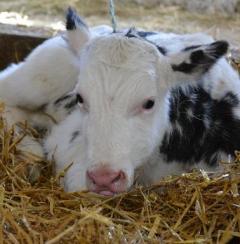Latest Knowledge Regarding Improving the Health of Dairy Calves
Management Practices of the Dam Impact the Health of Dairy Calves Long Term

Management of Dam Impacts Calf Health Long-Term: The health of a calf is impacted by the nutrition and management programs for her dam and of which occur prior to the calf’s actual birth. During the last trimester of pregnancy, a great expansion of fetal immune cells occurs and, as such, nutrition and disease in the dam can affect the fetus long term. Diseases and their resulting metabolic responses in the dam may impact their offspring. These negatively-related disease responses can occur in their offspring not only shortly after birth, but also throughout their life, even after these offspring calve themselves. Insufficient nutrition during gestation results in calves having reduced immunity, increased incidence of diarrhea and respiratory disease, decreased titers in response to a vaccine (vaccines are not as effective), and increased incidence of mastitis later in life. Research is also starting to look at the possible effects over-conditioning of dry cows may have on their offspring, not just on the cow herself; more to come on this effect in the future. Good news, studies where dry cows were fed anionic salts showed no effect on the health and antibody absorption of calves born to dams fed these diets. (Abuelo, Michigan State)
Heat Stress on Dry Cows Impacts 2+ Generations: Negative impacts of heat stress on the dam carry over for at least two generations of their offspring. Calves born to heat-stressed dams have lower lifetime performance (4.8 lbs/day), are less likely to survive to first calving (11% less survival rate), and have a reduced lifespan by 11.7 months. Research is ongoing to explain these differences and the changes that are occurring as they relate to the regulation of genes in their offspring. (Laporta, Univ. of WI-Madison)
Nutrition May Impact Wound Healing: Preliminary studies have indicated that a higher plane of nutrition may help calves heal quicker from disbudding than those calves fed a lower plane of nutrition (10 vs 5 quarts/day of milk). Pain management during disbudding needs to include both the use of lidocaine and an anti-inflammatory drug (NSAID) such as meloxicam. The effects of lidocaine generally wear off within 60 minutes and meloxicam provides longer term pain management. Both need to be used under the direction of your local veterinarian. If you have not used lidocaine for a nerve block in calves before, ask your veterinarian to show you how to administer this pain management protocol and then inject a couple of calves yourself under their direction. (Winder, Univ. of Guelph)
Non-antibiotic Disease Treatments/Preventatives: Research is on-going to find ways to prevent respiratory disease through the use of immunomodulatory injectables or feed additive products. The goal is to help calves mount a heightened immune response to fend off disease and, thus, decreasing antibiotic since it will not be necessary. These treatments attempt to help the immune system respond quickly to a disease challenge preventing its negative effects. (McGill, Iowa State)
Understanding Factors Which Impact Colostrum: Research is on-going to better understand the factors that impact the quality and quantity of colostrum. In more recent studies, researchers found that colostrum quality, as measured by the IgG concentration, did not vary between first and second lactation. Third and later lactations did have a higher IgG concentration versus the first 2 lactations, but all lactations were above the threshold we use to describe high quality colostrum. Thus, colostrum from first-lactation cows may be of high-quality and can be fed and/or saved and frozen for later use. As always, quality should be measured using a refractometer prior to feeding.
Little difference in colostrum quality was noted as long as the dry period was between 30 and 60 days in length. Stresses on the dam that prevented oxytocin release (milk letdown) at the first milking may also result in lower quality colostrum. Colostrum volume or yield only explains 14% of the variation seen in IgG concentration; other factors are at play than just colostrum yields. A seasonal pattern has been shown for colostrum yield, being lowest in the fall and winter and highest in the summer. When using frozen colostrum, colostrum should be checked for quality, frozen quickly after harvest, stored in a freezer that is NOT frost-free (most freezers in a refrigerator combo are frost-free), thawed in a bucket of warm water where the water is between 110 and 140ºF, and fed within an hour of removal from the freezer. (Mann, Cornell)
Author: Donna M. Amaral-Phillips
